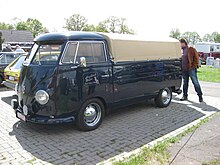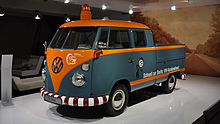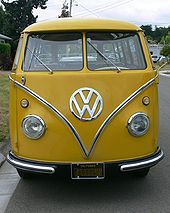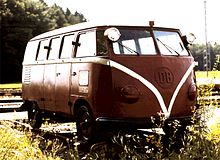VW T1
| Volkswagen | |
|---|---|
|
Volkswagen Type 2 T1
|
|
| Type 2 T1 | |
| Manufacturer: | Volkswagen |
| Sales designation: | Bus, van |
| Production period: | 1950-1967 |
| Previous model: | none |
| Successor: | VW T2 |
| Technical specifications | |
| Designs: | Minibus , box truck , flatbed truck |
| Engines: |
Petrol engines : 1.1–1.5 liters (18–32 kW) |
| Length: | 4280-4290 mm |
| Width: | 1750-1800 mm |
| Height: | 1920-1940 mm |
| Wheelbase: | 2400 mm |
| Payload: | 0.86-0.93 t |
| Perm. Total weight: | 1.75-2.07 t |
The VW T1 , more precisely VW Type 2 T1, also known as the Bulli , was a small van from Volkswagenwerk GmbH (from 1960: AG). The T1 was the first model in the VW bus series, the models of which are officially called VW Transporter and internally Type 2 . After the VW Beetle , internally type 1, the VW bus is the second series of the VW plant for civil use and is still produced today as the VW T5 / T6 . The transporter was developed from 1949 and brought to market maturity in 1950 . The car, which was the market leader during its construction, is a symbol of the German economic miracle . One of the first motorhomes was built on its basis.
In the Wolfsburg plant and in the Volkswagen plant in Hanover (from 1956) a total of 1.8 million T1 in various versions rolled off the assembly line. With the start of production of the successor model VW T2 in the Hanover plant, production of the T1 ended in 1967.
In contrast to the later further developments of the VW bus in its retro design , a VW Microbus reminiscent of the T1 / T2 models was presented by Volkswagen as a concept vehicle in 2001 , but did not reach series production.
Model history
General
After the Second World War , the Volkswagen plant in Wolfsburg was under the control of the British occupying forces . Major Ivan Hirst was responsible for the "Wolfsburg Motor Works". To keep production going, he borrowed vans and forklifts from the British Army. If the army needed them elsewhere, they were no longer available to the plant. In order to resolve the transport bottlenecks, a panel wagon with parts from the VW Type 82 "Kübelwagen" was developed, with the driver sitting at the rear above the engine.
concept
During a visit to Wolfsburg in early 1947, the later Dutch general importer, Ben Pon , saw the pickup truck and proposed a commercial offshoot for the Dutch market based on the chassis of the VW Beetle . However, the planning failed because the Dutch authorities did not want to issue an operating license for a vehicle with the driver behind the load. Pon met on April 23, 1947 in Minden on Colonel Charles Radclyffe of the "Trade and Industry Division" of the British military administration. At the meeting, Pon made a sketch of a closed van for a payload of 750 kg, with the driver sitting in the front and the engine installed in the rear under the floor of the cargo space. The term "box van" originated from the shape of a box.
development
After the meeting, Radclyffe announced to Hirst that there would be no Beetle-based transporter due to the lack of production capacity. Hirst, who saw a market for small vans in Germany, gave Pon the prospect of further developing the concept if the situation in Wolfsburg improved. Heinrich Nordhoff became the new general director of the Volkswagen factory at the beginning of January 1948 . In autumn 1948, he commissioned the new development manager, Alfred Haesner, to develop a prototype based on Ben Pon's concept. Haesner created two designs, one with a flat and one with a curved front. Nordhoff opted for the curved shape. In the first wind tunnel tests the scale model of the transporter reached a c w -value of 0.75. A new, more streamlined design achieved a cd value of 0.45, a little less than the Beetle (0.48). The fuel consumption at 70 km / h could be reduced by 2 liters / 100 km.
The first prototype was operational on March 11, 1949. Tests carried out exclusively at night showed after a month that the chassis of the Beetle was not suitable for the higher load on the van. Despite the failure and the initial perplexity of the engineers, Nordhoff insisted that production should start at the end of 1949. For the second prototype, the developers designed a new floor assembly with two longitudinal members instead of the central tube. The front crank arm axle is bolted to the shock absorber mounts with the cranked longitudinal members. The Beetle's engine was also not up to the requirements. Porsche KG , commissioned with the further development, changed the gear ratio for better acceleration, but thereby limited the top speed to 80 km / h. The new prototype proved itself in the tests. The rear axle to the wheel-side back gears corresponds to the VW Type 82 .
In addition to the panel van with a cargo space of 4.59 cubic meters, of which there were a total of six prototypes, a bus with windows for passenger transport was also developed. A partition was provided between the driver and the rear passengers up to the lower edge of the window. When converting to machine series production, the roofs in particular turned out to be problematic.
The new transporter was presented to journalists on November 12, 1949, one week late after a 51-week development period.
Serial production
Series production of the transporter began on March 8, 1950 at the VW plant in Wolfsburg. The price of the "Type 2" was 5850 DM, 150 DM higher than the price of a fully equipped Beetle. Adjusted for inflation, this corresponds to around EUR 16,400. The more spacious Tempo Matador with front-wheel drive, which was offered around the same time, cost 7100 DM. The series T1 had a front with a split windshield made of flat glass. The VW trademark was emblazoned in the middle of a V-shaped bead. The dimensions of the first production model were 4150 mm long, 1660 mm wide and 1900 mm high, with a wheelbase of 2400 mm. The curb weight was 975 kg and the payload, as outlined by Ben Pon, 750 kg.
Like the front windows, the side windows were made of flat glass. The doors of the driver's cab each had a small vent window. Unlike the Beetle, the body was welded to the frame. In the driver's cab, the sheet metal dashboard with an integrated speedometer was screwed to the body. The steering wheel was flat and larger than the Beetle. Like the prototypes, the first T1 had no rear bumper or rear window. The fuel tank was only accessible through the bonnet. From 1952 a trapezoidal rear window was installed. In the first few years the T1 was only available in pigeon blue or primed. Later two shades of gray, pigeon blue, brown and beige as well as two-tone paintwork were on offer.
The T1 was powered by the Beetle boxer engine with 1131 cm³ displacement and 25 HP (18 kW) installed in the rear . Because of the rear engine, it had no continuous loading area. As in the VW Type 82, the chassis consisted of a front double crank-arm axle with two torsion bar springs (spring assemblies) lying one above the other and a horse-drawn steering . The rear axle was a pendulum axle with a countershaft ( portal axle ). Two gears reversed the direction of rotation in the lap by the wheels and caused a reduction. The transmission from the Beetle was taken over with a changed ratio of the second gear. Because of the countershaft, the differential was installed in mirror image, the axle drive shafts in the pendulum axle tubes thus rotated in the opposite direction to those of the Beetle. The VW T1 had hydraulic drum brakes .
Nickname Bulli
The contemporary name of the VW T1 was "Kombi", under this the vehicle is u. a. known in Brazil to this day. More recently, the classic car (and some of the successor models) has been advertised as the "Bulli". The first use for this vehicle is not clearly passed down. One version says that the combination of the first two letters of "bus" and "delivery van" led to the name. Another version ascribes the name to the adjective "beefy", which VW employees are said to have used to describe the T1 during the development of the T1.
VW did not use the name until 2007 because the naming rights were held by Kässbohrer Geländefahrzeug AG . On the occasion of the 60th anniversary of the series, Kässbohrer sold the name to VW. In the English-speaking world, the nickname “Splittie” has established itself for the first generation of VW buses because of the split windshield. There “Bully” ( English for “tyrant”) has a negative connotation; "Bullying" means bullying . In German, the term “bully” has always been used to describe the throw-in in ice hockey .
Further development
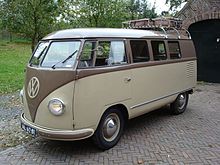
From mid-1953, the factory installed a gearbox with synchronized 2nd to 4th gear. The following year the T1 got a more powerful engine with a displacement of 1192 cm³ and an output of 30 HP (22 kW). In addition, all vans received a rear bumper. From August 1955, a fresh air supply for the interior was added above the windshield. The spare wheel was moved from the engine compartment behind the driver's seat and the car received duplex brakes on the front axle .
In 1956 VW moved T1 production to the new Volkswagen plant in Hanover .
In the 1959 model year, the bumpers were changed. After the indicators were legally introduced in 1960, the indicators that had been built into the B-pillar were no longer applicable . From then on, conical indicators were installed above the headlights, which Volkswagen later replaced with oval indicators. At the same time, the transporter and the VW Beetle got the asymmetrical low beam , at that time still with 6 volts. The taillights also went through several changes, from small round lights with a single separate brake light to a larger oval shape with integrated turn signals and brake lights.
The output of the 1200 cc engine increased to 34 hp (25 kW) in 1960, and the gearbox was fully synchronized. Two years later, the heating was changed due to an official requirement: The engine's cooling air, which was heated directly by the cylinders and possibly contaminated with oil and gasoline vapors, was no longer directed into the passenger compartment. With the new “fresh air heating”, air taken from the engine cooling fan was heated by finned heat exchangers (“heating bulbs”) on the exhaust pipes and used to heat the car. In the same year 1963, the more powerful 42 HP engine with 1500 cc displacement was initially only available for the flatbed truck. The 34 hp engine was no longer used in the Transporter in 1964, and the 42 hp engine that was only offered was increased to 44 hp (32 kW) in 1965 with a different carburetor. In the last model year, 1967, the cars were fitted with a 12 volt electrical system .
The body also changed over time. Most of the innovations were made in 1963: The tailgate was widened and got a larger window. Instead of the double-leaf cargo area door, a sliding door could be ordered, and the VW Transporter was available with a reinforced chassis with a payload of one ton.
Production numbers
The 100,000th T1 was manufactured on October 9, 1954 at the VW plant in Wolfsburg. After the T1 production was relocated to the new Hanover plant, the millionth copy rolled off the production line there on October 2, 1962. By the time the T1 was replaced in July 1967, a total of 1.8 million units had been produced.
When production began in 1950, the van was exported within Europe, South America and the United States. From two copies imported in 1950, imports in the USA increased to 3,198 vans in 1955. The export quota in 1950 was almost 20 percent. Of a total of 8,041 vehicles, 1,579 went abroad.
Models
The T1 was available as a panel van, station wagon and minibus. There were also vans with a high roof, a large side flap that could be opened up as a mobile sales stand, as well as ambulances, police, fire engines and hearses. The special model called "Samba", the Westfalia camping bus, the flatbed truck and a version with reinforced bumpers and front windows that can be set up for hunters were other designs. VW manufactured variants with other combinations of the presented body features for other markets and to order. The T1 was available as a right-hand drive for various export countries .
Box vans, station wagons and minibuses

The closed box van was available with a flat and a high roof. The station wagon had three windows on the sides behind the cab. The minibus had seven to nine seats for passenger transport, and the rear bench seats could be expanded to carry loads. The price for a panel van was 5925 DM in 1955 and for the station wagon 6600 DM.
Pickup truck
From 1951, in addition to the panel vans, platform trucks were also available, initially with a three-seater driver's cab. The loading area was continuous at the level of the engine compartment. The side walls and the tailgate could be folded down. Between the engine compartment and the driver's cab there was a protected cargo space below the loading area, which could be reached behind a side flap. The bed could be covered with a tarpaulin and bow . The flatbed truck was a commercial success and was only slightly below the box truck in terms of sales. The flatbed truck was also available with an enlarged wooden platform. In 1955 the flatbed truck cost DM 5,725.
From 1959 there was the double cabin with six seats, called "Doka" for short. The rear bench seat in the double cab was accessible through a second door on the passenger side. Under the rear bench there was access to a protected storage space.
Special model ("Samba")
The eight-seater special model (official name in the VW range) or type 24S (later type 24G, from 1954 type 241), known in the English-speaking world as “Microbus Deluxe”, was launched at the first post-war IAA in April 1951 presented in Frankfurt. It had chrome hubcaps and a polished VW badge on the front; until the end of 1951 a three-color, then a two-color or rarely single-color paint scheme. The different colored areas were separated by chrome strips. The equipment also included a tube radio and a folding sunroof over the passenger area. From March 10, 1953, a rear bumper was mounted, which the other T1 variants only received from December 21, 1954.
The eight to twelve-seater bus had 23 windows. Until the model change in 1955, a tailgate to the interior was only available as additional equipment at an additional cost. The two rear corner windows and the eight roof windows were initially made of 4 mm thick Plexiglas . The rear window was larger than on the other T1. The Samba had a dashboard the width of a vehicle, which was taken over into series production in a modified form in 1955. Access to the rear row of seats was made easier by a fold-away backrest on the right-hand seat in the middle row. From August 1963, the rear corner windows gave way to a modified tailgate with a larger window. On models with individual front seats, the spare wheel was attached to the left above the engine compartment.
The Samba was on offer until the model change in 1967; There was no equivalent replacement for the successor model T2. In the first year 269, in 1959 6241 units were produced. Last year VW produced 18,790 of this special model. The price in 1955 was 8,475 DM, which corresponds to a purchasing power of around 21,700 euros.
Westfalia
The vehicle manufacturer Westfalia offered a camping box for the T1 from 1950. So the bus should be equipped for a weekend on the road. The box contained a gas stove, space for two gas bottles and a folding table. An additional cupboard was provided for the space above the engine compartment. Shelves could be hung on the double doors. All parts were designed to be removable in order to offer the combination of work equipment and recreational vehicle.
A permanent conversion to a camper van was carried out by Westfalia in cooperation with VW from 1961. The camper vans had a folding rear bench for two beds, a water tank and several cupboards. Two berths for children were provided lengthways in the cab. A two-burner stove, a cool box and a mobile chemical toilet were available for an additional charge . A folding roof and a pop-up roof were offered as special equipment , under which an adult could stand upright in the T1.
VW Brazil
The Volkswagen do Brasil Ltda. first manufactured the T1 in 1953 from prefabricated, imported parts. A special form was built without heating, which had four side windows behind the driver's cab. From 1957 to 1975 station wagons and buses with their own parts were produced in series. Another model had double flap doors on both sides.
After the T1, a mixture of the T1 and the successor T2 was produced in Brazil. The model, which was manufactured until 1997, consisted of the extended front part of the T2 with a one-piece curved windshield and the rear of the T1. This model also had drum brakes at the front and rear, but already had a ball joint front axle with longer suspension travel. There was a water-cooled diesel engine from 1982 to 1984.
Railway trolley Klv 20 of the DB
In 1955, 30 railway draisines Klv 20 with VW transporter bodies from Beilhack (Klv 20-5001 to Klv 20-5015) and WMD ( Waggon- und Maschinenbau Donauwörth ) (Klv 20-5016 to Klv 20-5030) for built by the Deutsche Bundesbahn . The vehicles with seven seats were given a rigid front axle without steering and wheels with flanges . The vehicles could be lifted and turned or tracked off by a hydraulic lifting device mounted in the middle under the trolley. The weight (called "operating mass" by the railway) increased to 1500 kg, the maximum speed allowed was 70 km / h. The vehicles remained in service until the mid-1970s.
Market situation
| year | 1950 | 1951 | 1952 | 1953 | 1954 | 1955 | 1956 | 1957 | 1958 | 1959 | 1960 | 1961 | 1962 | 1963 | 1964 | 1965 |
| vehicles | 5476 | 8761 | 12,283 | 14,861 | 16,359 | 17,769 | 23,162 | 29,810 | 35,104 | 39,600 | 45,548 | 55,248 | 60,841 | 60,762 | 65,177 | 58,454 |
The range of vans with a payload of around 750 kg was limited at the beginning of development. Competitors of the T1 were the three-wheeled transporter Goliath GD 750 and Tempo Hanseat , launched in 1949 , based on a pre-war development. Also in 1949, the four - wheel Tempo Matador was added, which was initially powered by used engines from VW bucket trucks and beetles from Wehrmacht stocks . In the same year, the DKW Schnellaster appeared on the West German market, followed in the early 1950s by Lloyd's delivery vans , both vehicles with two-cylinder two- stroke engines and front-wheel drive . The Framo V901 / 2 and Barkas B 1000 produced in East Germany also had a two-stroke engine, but they were not offered in West Germany and therefore did not represent a competitor for the T1. Alfred Haesner, the former VW development manager who switched to Ford, designed the Ford FK 1000 in 1953 with a payload of one ton. The T1 had the largest market share for vans up to 1250 kg and reached 33.7 percent in 1956. In 1960 the proportion was 41.6 percent. In 1956, the market share of seven to eight-seat buses was 91 percent.
The trade press received the T1 largely positively. Werner Buck wrote about the minibus in Das Auto in September 1957 : “There are faster, more powerful and no less beautiful eight-seaters than those from Wolfsburg, but they are also more expensive and have to be because nobody can count on such high production figures as Wolfsburg . Then there is the legendary reputation of the VW engine, the robust construction and the trust credit ... "
Cultural meaning

When the T1 came on the market in 1950, post-war Germany was at the beginning of the economic miracle . The cities and transport routes in the country were partly still in ruins and production facilities were affected by war damage. Economic growth and falling unemployment improved the situation in Germany. In addition to the Beetle, the T1 is also a symbol of the economic miracle.
Motorhome
With the economic miracle at the end of the decade, the trend towards mass tourism, which had started before the war with the introduction of vacation entitlement and other developments, resumed. With the development of the camping box from Westfalia, the T1 was one of the first vehicles that were suitable for traveling and staying overnight in the car. Since the box was not permanently mounted, the car could continue to be used as a commercial vehicle in everyday life. With the camper van that followed in 1960, the new vehicle class of motorhomes was created .
Hippie bus
In the 1960s and 1970s, the hippie trails started from Europe to the east and south. Brightly painted and made habitable T1 and T2 were common as travel vehicles, also in the hippie movement of the United States, there the trips went to the west coast. Even more than the Beetle, the transporter became a symbol of movement. In art and culture, depictions of hippies with the T1 are common and even stereotypical. B. in the computer game Grand Theft Auto: San Andreas or the film about Uschi Obermaier's life Das wilde Leben from 2007. The Who sang about Type 2 in Going mobile (1971, Who's Next ). Pete Townshend commented : "The VW bus I wrote about in this song was the rolling hippie home . " In the 2006 animated film Cars , a 1960 VW bus plays the friendly hippie Fillmore .
VW was not happy about the spread of the VW bus among the hippies. The management feared a loss of image and a negative impact on the sales figures of the two most important products of the company.
Appreciation today
As a classic car, the VW T1 is very valued today and is comparatively expensive. In addition to the appearance, the positive symbolism of the economic miracle as well as the hippie movement, which is attached to the T1 to this day, so that it stands for economic success and at the same time cultural openness and diversity. The special version of the bus is particularly popular. In top condition, these Samba models now reach six-figure sales prices.
Technical specifications
VW Transporter T1 (1950-1967)
| 1100 (1950-54) | 1200 (1954-60) | 1200 (1960-64) | 1500 (1963-65) | 1500 (1965-67) | |
|---|---|---|---|---|---|
| Engine: | Four - cylinder boxer engine ( four-stroke ) | ||||
| Displacement: | 1131 cc | 1192 cc | 1493 cc | ||
| Bore × stroke : | 75 × 64 mm | 77 × 64 mm | 83 × 69 mm | ||
| Maximum power ( PS ) at 1 / min |
18.4 kW (25 hp) 3300 |
22 kW (30 hp) 3400 |
25 kW (34 PS) 3600 |
30.9 kW (42 hp) 3800 |
32.3 kW (44 PS) 4000 |
| Max. Torque ( mkp ) at 1 / min |
67 Nm (6.8) 2000 |
75.5 Nm (7.7) 2000 |
82.4 Nm (8.4) 2000 |
95.1 Nm (9.7) 2200 |
102 Nm (10.4) 2000 |
| Mixture formation : | A downdraft carburetor | ||||
| Solex 28 PCI | Solex 28 PICT | Solex 30 PICT-2 | |||
| Valve control : | OHV : bumpers and rocker arms , central camshaft driven by spur gear | ||||
| Cooling: | Air cooling with fan | ||||
| Transmission: | 4-speed gearbox, center shift | ||||
| Front suspension: | Crank arm axle with collar bolts, 2 transverse spring bars (packages) | ||||
| Rear suspension: | Pendulum axle with trailing arms , transverse spring bars | ||||
| Brakes: | Hydraulically operated drum brakes all around (front and rear Ø 230 mm) | ||||
| Body: | Self-supporting all-steel body with longitudinal and cross members | ||||
| Tank capacity: | 40 liters | ||||
| Track width front / rear: | 1370 (1375) / 1360 mm | ||||
| Turning circle : | 12 m | ||||
| Wheelbase : | 2400 mm | ||||
| External dimensions (1961): | Length: 4280/4290 mm, width: 1750/1800 mm (special model), height: 1920 mm (platform truck) / 1940 mm (panel truck) |
||||
| Empty weight: | 890 kg | 1140 kg | |||
| Payload: | 860 kg | 930 kg | |||
| Top speed: | 85 km / h | 90 km / h | 95 km / h | 105 km / h | 110 km / h |
| Consumption in liters / 100 kilometers: |
9.0 N | 9.5 N | 9.5 N | 9.2 N | 9.7 N |
literature
- Michael Steinke 2007: VW Bus / Transporter 1949–1979, Volume 1, Type Compass . Motorbuch Verlag, ISBN 978-3-613-02301-7 .
- Rudi Heppe 2002: VW Transporter 1950–1979 - graphics, pictures, brochures . Podszun, ISBN 3-86133-295-7 .
- Malcolm Bobbitt 2007: The Volkswagen Bus Book , Edition: 3, Veloce Publishing Ltd, ISBN 978-1-84584-081-5 .
- Richard Copping 2005: Volkswagen: The Air-Cooled Era in Color , Veloce Publishing Ltd, ISBN 1-904-78892-0 .
- William M. Burt 2003: Volkswagen Bus, MotorBooks / MBI Publishing Company , ISBN 978-0-76031-319-0 .
- Bernd Wiersch 2009: The VW Bulli, the transporter legend for people and loads . Delius Klasing, Bielefeld, ISBN 978-3-76882-579-5 .
- Modern technology in the VW transporter plant. In: Motor Vehicle Technology 7/1957, pp. 260–261.
- Jörg Hajt 2019: BULLI VW bus dreams from T1 to T3 , Heel Verlag Königswinter, 255 pages, ISBN 978-3-95843-897-2
Web links
- Official Volkswagen profile for the T1
- VWlibary - Contemporary driving reports from VW and Porsche models up to 1970
- Bullikartei eV via VW Transporter until 1967
Individual evidence
- ↑ Auto News . Retrieved August 17, 2017.
- ↑ a b Bobbitt 2007, p. 23 ff.
- ↑ a b Steiger, Wirth, wines: Transporter of the economic miracle. Heel Verlag, Königswinter 1996, ISBN 3-89365-464-X .
- ↑ Bobbitt 2007, p. 26 ff.
- ↑ Air resistance measurements on the VW delivery van . In: Automobiltechnische Zeitschrift . 6/1951, pp. 153-156.
- ↑ a b c d Bobbitt 2007.
- ↑ a b This figure was based on the template: Inflation determined, has been rounded to a full 100 euros and relates to last January.
- ↑ vw-bulli.de: The VW Bulli - how it all began , accessed on April 24, 2009
- ↑ Burt 2003, p. 18
- ↑ a b Bulli index eV: registrations and numbers , accessed on April 23 of 2009.
- ↑ a b c d F.G .: VW transporter with many innovations in Das Auto , issue 9, 1955, p. 16.
- ↑ Copping 2005, pp. 74 ff.
- ↑ Burt 2003, p. 28 f.
- ↑ Copping 2005, p. 70 f.
- ↑ TheSamba.com: Production Figures , accessed on 29 April 2009
- ↑ Copping 2005, p. 100 ff.
- ↑ Klv 20 VW - Draisine ( Memento of the original from July 18, 2011 in the Internet Archive ) Info: The archive link was inserted automatically and has not yet been checked. Please check the original and archive link according to the instructions and then remove this notice.
- ↑ Werner Buck: VW eight-seater "special model" in Das Auto, issue 16/1957, p. 10.
- ↑ Werner Buck: VW eight-seater "special model" in Das Auto, issue 16/1957, p. 12.
- ↑ a b 60 years of the VW Bulli - One for hippies and craftsmen , in Spiegel Online, September 26, 2007
- ^ Eduard Schütz 2005: The Volkswagen in François / Schulze: German places of remembrance: A selection , CH Beck, ISBN 3406522130 , p. 366.
- ↑ Christian Buß : In the VW bus for enlightenment in Spiegel Online , July 2, 2007
- ^ Wally Olins 2004: Brand, Brand, Brand: Strengthening the Brand , Campus Verlag, ISBN 3593374226 , p. 34.
- ↑ Oldtimer Markt special issue prices 2017
- ↑ Dieter Korp: Now I help myself , Volume 31, VW Transporter and Bus - all models up to June '79, Motorbuch Verlag, Stuttgart 1980, edition No. 108 28 11, ISBN 3-87943-210-4





